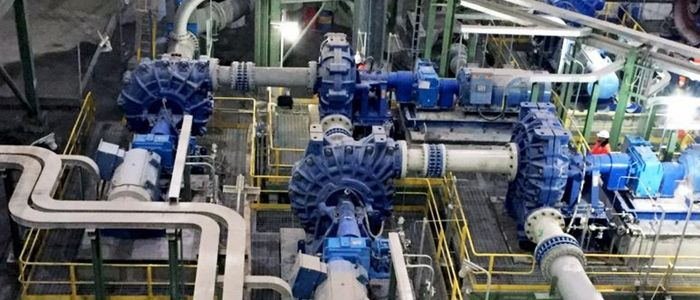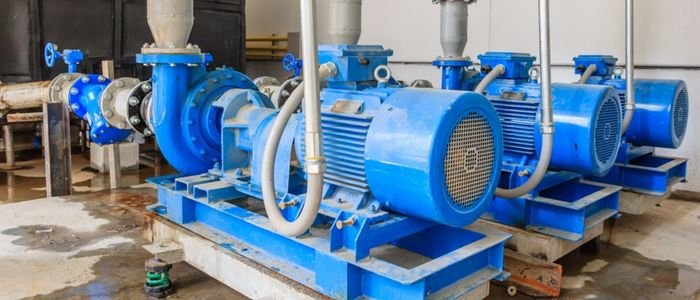One of the most widely used pumps for moving corrosive and abrasive materials is the industrial slurry pump. These pumps offer outstanding performance with affordable operating and servicing expenses. They come in single-acting and double-acting variants. Working with dangerous and corrosive materials is ideal for the pump’s stainless steel structure.
The applications mostly ask what kind of fluid you want to pump, how far you want to move it, and how much you need to move it in a certain amount of time. This article will discuss everything you need to know about industrial processes.
The Working Principle
The working principle of a slurry pump is straightforward. It uses centrifugal force to generate flow to move the slurry through the pump. The slurry is fed into the pump at high pressure, and the impeller then rotates, creating a centrifugal force that sucks the slurry into the pump. The slurry is then propelled out of the pump at a high velocity. This repeated process allows the pump to move large slurry with minimal effort.

The slurry pump is essential in many industries, including mining, chemical processing, and power generation. Slurry pumps move liquids with solids, such as slurries, mud, and other thick fluids. They are typically made of stainless steel or other rigid materials to withstand the abrasive nature of the slurry.
Slurry enters the pump through the eye of the rotating impeller, which generates a circular motion according to the slurry pump’s working principle. Centrifugal force propels the slurry between the impeller’s blades as it is thrust outward. By the time the slurry reaches the impeller’s edge, it has gone a high speed. Its high-speed energy is transformed into pressure energy in the casing. The pumps use centrifugal force to boost the pressure of a liquid and solid substance while converting electric power into kinetic energy to move the slurry. Pumping flammable and light slurry liquids are made simple and maintenance-free by this method.
Single-acting pumps use one impeller to draw the slurry into the pump and propel it out. Double-acting pumps have two impellers that work in tandem to move the slurry through the pump.
Slurry pumps are designed to operate with low energy, making them very efficient. They also have a very long lifespan, so they require little maintenance.
Working principle:
The slurry pump is a centrifugal pump that uses centrifugal force to create a vacuum at the pump’s inlet. This vacuum draws the slurry into the pump and propels it under high pressure. The pump’s impellers create the centrifugal force that moves the slurry through the pump. The number of impellers and their arrangement can vary depending on the slurry being pumped.
The size and power of the pump also need to be considered when choosing a slurry pump. Slurry pumps can be used in various industries, including mining, chemical, food processing, etc. Many slurry pumps are available today, so finding the right one for your needs can be challenging. Working with a reputable pump manufacturer is the best way to ensure you get the right pump for your application.

Some standard features of slurry pumps include:
- Ability to handle abrasive and corrosive materials
- Low energy consumption
- High performance
- Long lifespan
- Low maintenance requirements.
When choosing a slurry pump, your specific application is an essential factor. There are many different types of slurries, so it is necessary to select a pump desi the kind of slurry you will be conveying. For example, some pumps are designed specifically for abrasive materials, while others are better suited for corrosive materials. Working with a reputable pump manufacturer can help you choose the right pump for your needs.
In general, slurry pumps work by using centrifugal force to generate flow. The pump house contains an impeller that rotates at high speeds. This creates a vacuum on the suction side of the pump, which draws in slurry from the surrounding area. The slurry is then propelled outward by the impeller, where it exits through the discharge port.
Operating and maintaining a slurry pump is relatively simple. However, there are a few things to keep in mind to ensure that your pump continues to run smoothly. First, regularly checking the level of wear on the impeller and other moving parts is essential. If the wear is excessive, it can cause the pump to lose efficiency and eventually fail. Additionally, it is necessary to ensure that the slurry being pumped is not too dense, as this can also cause problems.
Following these simple tips, your slurry pump should provide years of trouble-free service.
Benefits of Slurry Pumps for Industrial applications
Slurry pumps offer several benefits for industrial applications.
The first benefit is that they effectively convey corrosive and abrasive slurry with low energy. This makes them much more efficient than other types of pumps on the market.
Slurry pumps offer several advantages and benefits that make them the perfect choice for many situations. A slurry pump is likely the best option if you need a pump for an industrial application.
- Easy maintenance
- Low capital costs
- Simple mechanism
- Robust machinery
- Stainless steel material to reduce wear and tear
Technology development is the primary driver is driving demand growth because it increased the efficiency of pumps to accomplish routine duties and improved their reliability. Additionally, it will probably use less power and perform better, enabling a more comprehensive adoption across end-use industries like water and wastewater, oil and gas, and construction.
Some Classifications of Pumps are:
Dynamic
- Centrifugal pumps
- Vertical centrifugal pumps
- Horizontal centrifugal pumps
- Submersible pumps
- Fire hydrant systems
Positive Displacement
- Diaphragm pumps
- Gear pumps
- Peristaltic Pumps
- Lobe pumps
- Piston Pumps
How it Works?
When the pump is running, there is a rise in fluid pressure from the pump’s inlet to its exit. The fluid is forced through the system or plant by the pressure differential. Priming a pump is most likely the first and most crucial step you should take before using it. 80% of centrifugal pump issues are caused by improper or nonexistent priming. Despite centrifugal pumps being reasonably priced, system downtime brought on by a bad pump could be expensive.
Applications of Slurry Pumps

Slurry pumps are widely used in many industries because they can effectively handle corrosive and abrasive materials. Applications of Slurry Pumps:
- Mining
- Construction
- Dredging
- Pulp and paper
- Power generation – Pumping crude oil, sludge, and mud for use in refineries and power plants
- Wastewater treatment – Municipal businesses, wastewater treatment facilities, and drainage
- Food and beverage processing
- General industrial applications – Paints, petrochemicals, cellulose, mining, hydrocarbons, petrochemicals, food, and beverage manufacturing
Process of Slurry Pumps for Industrial Applications

The process of Slurry Pumps for Industrial use is as follows:
- Running without water is severely prohibited. Refuel using a thin oil-lubricated slurry pump in accordance with the oil standard’s oil level.
- Before driving, the packing must be increased as necessary. The supply of shaft seal water is ensured by a mechanically sealed pump.
- Driving without oil is severely prohibited. The mechanical seal can only be installed after the pump coupling or pump pulley has been driven, protecting it from damage caused by the impact force, when installing the pump coupling or pump pulley.
Importance of Slurry Pumps for Industrial Applications
Slurry pumps are an essential tool for moving slurry over any distance efficiently in mining and ore processing processes. Their maintenance expenses make up a sizable portion of overall operating costs, and any malfunction of this vital piece of machinery can put a mining project to a grinding halt. Therefore, mining operators could gain significantly from increases in the long-term effectiveness and dependability of slurry pumps.
Slurry pumps gain from routine maintenance because it increases wear life, prevent unscheduled downtime, and lowers total ownership costs for end users. Slurry pumps are frequently operated to the point of failure before intervening in the punishing, demanding world of mining. In the short term, this could appear advantageous, but in the long run, you might be doing your plant a disservice.
- To remove suspended solids.
- Corrosion-free
- To avoid overheating
- To remove abrasive media
Thus, slurry pumps play an essential role in various industrial applications, making the work easier, faster, and safer.
In short, slurry pumps are essential equipment for many industries due to their reliability and effectiveness. Choose a reputable manufacturer to get the most out of your investment.
To learn more about our industrial pump range, don’t forget to visit our website.
Summary
For almost every application that calls for fluid operations, there are numerous industrial pump manufacturers who produce pumps. There are numerous different types of fluids in the industry; in order to move these fluids from one location to another, industrial pumps are needed. These fluids might be anything from food to wastewater to chemicals to oils to fuel. What are the functions of each of these distinct pumps? To find out, read on.
Thanks to their design, these pumps are perfect for various applications. Slurry Pumps for Industrial use are an essential part of many industries, as they allow for the effective and efficient conveyance of slurry with a low amount of energy. The process is reliable and safe, making it a crucial element of many production processes. Thanks to their unique design, these pumps are perfect for handling erosive materials.


